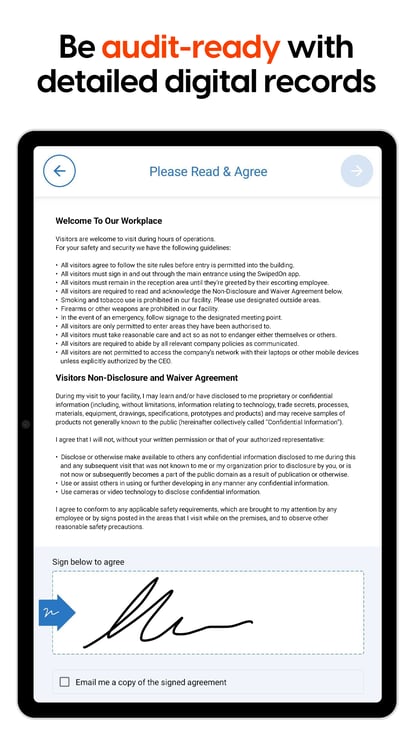Why Your Workplace Needs a Solid Digital Visitor Agreement

Digital visitor agreements are becoming an integral part of workplace sign in solutions because of the ease they bring to collecting documents like non-disclosure agreements (NDAs), invoicing, and more. In this article we will discuss the most important aspects of collecting digital agreements.
The purpose of a digital workplace sign in system extends beyond offering tech-forward solutions to visitors for a streamlined check-in process. It’s also expected to protect the interests of both the business and its visitors - which means a visitor management system should meet compliance and security standards concerning data privacy and provide the capabilities to offer a digital visitor agreement.

3 Benefits of Digital Visitor Agreements
1. Increased Security
In most organizations, the lobby is the first point of contact and defense for physical building security. CCTVs and alarm systems help meet security needs - and so do non-disclosure agreements.
NDA forms outline the rules and regulations that guests must review, sign, and comply with. Since they are digital and fully integrated into the system, collecting consent and agreement is easy and ensures better compliance. Unlike the traditional pen-and-paper logbook, digital agreement forms securely store visitors’ personal details, making tracking and monitoring easier in the event of a security breach and keeping their data private.
2. Better Compliance with Data Laws
Digital visitor agreements are also a good way to ensure operations comply with data protection laws. The General Data Protection Regulation (GDPR) is one of the most extensive privacy regulations in the world and guides the collection and storage of personal data by companies. A workspace management system is designed to ensure these requirements are met.
With a digital visitor agreement, guests can see how the company plans to use their personal details, including retention and disposal. In some cases, it may give them the option to opt out or anonymize.
3. Reduced Paper Use and Waste
Digital agreements reduce the reliance on paper and increase security. Confidential or sensitive paper documents must be handled and eventually disposed with extreme care. Data stored in digital agreements is easier to protect from unauthorized viewers, recall as needed, and can be easily erased when no longer required.
3 Considerations For Your Digital Visitor Agreement
As more and more organizations adopt a digital visitor management system to streamline their operations, it’s important to ensure that best practices are followed. Here are some factors to consider when building a digital agreement system:

1. Regulatory Compliance and Transparency
First and foremost, the digital agreement must comply with regulatory requirements, particularly those that collect electronic signatures and personal data. Failure to comply can have costly consequences. GDPR non-compliance can cost companies from €10 to €20 million (currently also about $10 to $20 million USD), depending on the severity of the offense.
Systems must also allow visitors to opt out when they disagree with the data collection and use statements. Agreements must be transparent and clearly show the terms and conditions for guests to read before signing.
To increase visitors' willingness to provide data, the system must provide them with information on how their data will be used. Some of the reasons are:
- Security: to monitor areas visitors will have access to
- Internal reporting: to understand the number and type of visitors within the building
- Ease of access: to allow frequent guests to automate their log-in process for their next visit
- Risk management and evacuation: to keep an accurate record of occupants for emergencies.
Another valuable function to include is data anonymization and disposal. The digital agreement form must include the company's measures to remove data according to a predetermined timeline. This helps reduce the number of people affected in the case of a data breach.
In the US, identity theft is a major concern, with consumers losing more than $3 billion to fraudulent transactions. And the cost for companies is going up—rising 13% since 2020.
2. Software Integration
With compliance requirements evolving, companies need a solution they can integrate seamlessly into their systems. Developing software from scratch is impractical when there are third-party systems with a proven track record that can help streamline the process and ensure organizations are compliant in no time. Software integration also ensures there will be no operational disruption.
3. Custom Solution
One of the major advantages of using third-party software is customization. Digital agreements can be aligned with the needs of the organizations. For instance, digital agreements can be used to process invoices, sign waivers, secure non-disclosure agreements (NDAs) and other legal documents. The applicability isn’t limited to visitors but can also include employees, vendors, and partners.
Digital Agreements Streamline Regulatory Compliance, FACT 💫
With digitalization becoming more prevalent, organizations should explore digital agreements as part of their workplace management. Not only do they simplify the sign-in process, but they also help ensure organizations meet compliance requirements and protect their staff and premises.



-929560-edited-003563-edited.jpg)





 Germany - Deutsch
Germany - Deutsch